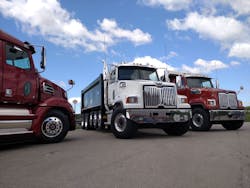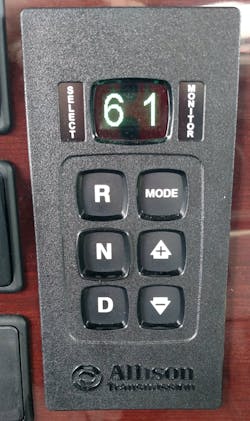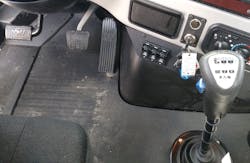3 Transmissions Face Off in Test Drive
If you’ve been around trucks a while, you probably like a manual transmission. Automatics, on the other hand, are increasingly popular as the industry draws on younger workers with differing skill levels. Then there’s a third type: the automated manual transmission, or AMT, which combines the virtues, and drawbacks, of both.
Recently I test drove, or Field Tested, all three within a couple of hours, thanks to the folks at Fyda Freightliner-Western Star at Zanesville, Ohio.
Like many dealers, Fyda keeps numerous heavy trucks in stock at its various locations, and this branch’s sales manager, Tony Apollonio, reported that he had new Western Star 4700SF dump trucks with both manual and automatic transmissions, as well as a Western Star 5700XE highway tractor with an automated gearbox. All had Detroit engines—DD13s in the dumpers and a DD15 in the tractor. The dealership sits between Interstate 70 and paralleling U.S. 40, which allowed a brief but revealing test route: west on 40, the old main east-west road with uphill and downhill stretches that require some gear changes, then back via I-70 for higher speed running in top gear.
Driving the AMT
The automated manual transmission was a DT12, an electronically controlled 12-speed that’s based on a German design but adapted to North American conditions. It’s built by Detroit (formerly Detroit Diesel), the axle, engine, transmission, and electronics manufacturer owned by Daimler Trucks North America, the parent of Freightliner and Western Star. The DT12 is primarily an on-road transmission but operates a lot like two series of competitor AMTs, Eaton UltraShifts and the Volvo/Mack I-Shift/mDrive, which do include versions for severe on/off-road use.
Like most AMTs, the Detroit DT12 was a bit touchy in starting out because once you select Drive, you must feather the accelerator to get the clutch to apply. There’s no clutch pedal, but there is a clutch and the driver needs to avoid riding it, for example, to keep a truck from rolling backwards at a stoplight. That’s called abuse. But once underway, the DT12 shifted smoothly and always seemed to choose the correct ratio for the situation. That included skip-shifting at low speeds because there was no trailer hung on the tractor’s fifth wheel.
Bobtailing with a tractor is actually a good test of an AMT’s operation because a loaded trailer usually requires using most or all of the gearbox’s ratios, and shifting is therefore logical to the controller’s “brain.” Skip-shifting—say, going from 2nd at start-out to 4th, then 7th, then 10th and up to top gear—requires more thinking, just as a driver would do with a manual transmission. In 12th at 70 mph on I-70, the engine turned at 1,400 rpm, just about right for highway cruising. An AMT shifts faster than most drivers can, removes most of the work of driving a truck, and is easier on the driveline because clutch and gear engagements are usually very smooth. Because it’s a mechanical gearbox, there’s a feeling that power is moving efficiently through the driveline to the rear wheels. But all of this is moot for vocational trucks, Apollonio said, because there’s no call for AMTs among those customers.
Driving the automatic
What has become popular in heavy Freightliner and Western Star vocational trucks, at least in areas served by Fyda, is the Allison torque-converter automatic. “Eighty to 90 percent of vocational trucks get an Allison,” Apollonio said, because it’s so easy to drive and is “bulletproof” in reliability. Ease of operation is important because most young people have never driven a manual of any kind, so learning how to operate a non-synchronized gearbox is asking too much of them, fleet owners find. This makes finding new drivers difficult, but not if you run automatics.
Allisons have been in use since the late 1940s. Today’s products have precise electronic controls and keep the torque converter locked most of the time for efficiency. Most versions are 6-speeds, like the one in the Western Star dump I drove. It was a 4500 RDS (Rugged Duty Series) that is about as simple to drive as anything out there. Punch D on the dash-mounted keypad, release the parking brakes, and off you go. The truck scooted away from dead stops with no fuss, and quickly upshifted to 5th and 6th. Programming favored high ratios and low engine revs, which made the powertrain feel a little sluggish even though the truck moved along nicely. As I slowed down, the Allison downshifted appropriately; with the engine brake switched on, it downshifted more actively to help further retard road speed and added a nice burble to the exhaust note. This was especially helpful on downgrades and an off-ramp from I-70.
It’s difficult to abuse a driveline because of an Allison’s cushioning effect, so it also reduces maintenance, fleet managers have found. Perhaps best of all, drivers can keep their minds on the road and the delivery job, and at the end of a day, they’re not nearly as tired as they are with a manual transmission. This is also true of AMTs, fleet owners have told me.
Driving the manual
Double-clutchin’ and gear jammin’ was once a big part of truckin’, but now manual transmissions are for “price-sensitive buyers,” Apollonio said. As standard equipment, an Eaton “8LL” saves several thousand dollars over an AMT and $7,000 to $8,000 compared to an Allison. That’s why he keeps at least one truck on the lot with a manual, “but it’s one manual for every nine or 10 Allisons, and that manual is the one that sits here the longest.” The one I drove saved some more money with a lower-rated DD13—470 horsepower versus 505 in the Allison-equipped truck. Both, by the way, had Rhodes 21-foot steel dump bodies, reflecting another trend: “Steel weighs just a little more than aluminum because of the Hardox high-strength steel they use now, and steel is more versatile. There’s hardly any call for aluminum anymore.”
More properly called RTLO-16908LL, the 8LL transmission is easy to operate, at least in the on-road driving gears. You move the lever for each gear change, and go through the H pattern twice, using the range switch on the lever. With the dump bed empty, I usually started in 2nd (the third ratio), and up- or downshifted as needed. Those steel gears made the truck respond instantly to my throttle inputs. The speed limit on U.S. 40 east of Zanesville is 45 mph, and there the engine lugged without complaint at around 1,000 rpm in 8th or at a lively 1,300 in 7th. At the other end of the operating scale, an 8LL has low-low ratios, activated by a blue thumb switch on the lever’s knob. It’s akin to shifting a 4x4’s transfer case into low; you can go through all five of the Eaton’s low-range gears, which will start a truck easily on steep inclines and crawl out of deep dirt or mud. With an overdrive top gear, it will still cruise nicely on the open road.
The clutch pedal took a bit of leg effort to punch, and clutch engagement was in the last half of upward pedal travel, but I soon got accustomed to it. The gear teeth are shaped so they mesh tightly and efficiently transfer power and torque. However, that, plus the quick fall in revs with electronically controlled diesels, make them a little tricky to shift, and for the first few minutes my gear changing involved a bit of crunching. Then I remembered to shift fast, and from there it was silent and easy going, and I got pretty good with it.
I would have enjoyed many more miles with this truck, and concluded that I might choose the 8LL for myself and the Allison for the young whippersnappers I’d have to hire. Then again, maybe I’d spec a good automated gearbox and just enjoy the ride. What do you do?



